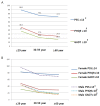Concomitant Psychiatric Symptoms in Neurological Outpatients
- PMID: 30857273
- PMCID: PMC6427503
- DOI: 10.3390/ijerph16050860
Concomitant Psychiatric Symptoms in Neurological Outpatients
Abstract
To estimate the prevalence of concomitant psychiatric disorders in neurological outpatients and to assess the value of simple screening questionnaires in the identification of psychiatric symptoms, we analyzed a total of 803 patients who visited neurology clinics with neurological symptoms over a six-month period. Using self-reported questionnaires, we assessed psychiatric symptoms, such as stress (Perceived Stress Scale, PSS), depression (Patient Health Question 9, PHQ9), and anxiety (Generalized Anxiety Disorder 7, GAD7). According to the disease subtypes, we analyzed the psychiatric scales based on gender and age group. The prevalence of psychiatric comorbidities was lowest in patients with cerebrovascular disease (CVD) and highest among patients with cognitive decline and epilepsy. The overall prevalence of psychiatric symptoms markedly decreased with age. This decline was statistically significant for all questionnaires (PSS ≥ 14, p for trend = 0.027; PQH9 ≥ 10, p for trend = 0.005; GAD7 ≥ 10, p for trend = 0.002) and was more pronounced in males. Considering the high incidence of undetected psychiatric comorbidities and their associated burden, proactive psychiatric management should be included in neurological care. Psychiatric questionnaires could also be an effective screening tool for identifying psychiatric symptoms accompanying neurological symptoms.
Keywords: anxiety; cognitive dysfunction; comorbidity; depression; neurology; outpatients.
Conflict of interest statement
The authors declare no conflicts of interest.
Figures


Similar articles
-
Predictors of psychiatric comorbidity in medical outpatients.Psychosom Med. 2003 Sep-Oct;65(5):764-70. doi: 10.1097/01.psy.0000079379.39918.17. Psychosom Med. 2003. PMID: 14508018
-
Principal and additional DSM-IV disorders for which outpatients seek treatment.Psychiatr Serv. 2000 Oct;51(10):1299-304. doi: 10.1176/appi.ps.51.10.1299. Psychiatr Serv. 2000. PMID: 11013331
-
Psychiatric disorders moderate the relationship between insomnia and cognitive problems in military soldiers.J Affect Disord. 2017 Oct 15;221:25-30. doi: 10.1016/j.jad.2017.06.023. Epub 2017 Jun 13. J Affect Disord. 2017. PMID: 28628764
-
Gender differences in the use of psychiatric outpatient specialist services in Tromsø, Norway are dependent on age: a population-based cross-sectional survey.BMC Health Serv Res. 2015 Oct 22;15:477. doi: 10.1186/s12913-015-1146-z. BMC Health Serv Res. 2015. PMID: 26493268 Free PMC article.
-
Mediating effects of self-stigma on the relationship between perceived stigma and psychosocial outcomes among psychiatric outpatients: findings from a cross-sectional survey in Singapore.BMJ Open. 2017 Aug 29;7(8):e018228. doi: 10.1136/bmjopen-2017-018228. BMJ Open. 2017. PMID: 28851803 Free PMC article.
Cited by
-
Multivariate base rates of potentially problematic scores on the NIH Toolbox Emotion Battery.Arch Clin Neuropsychol. 2024 May 21;39(4):454-463. doi: 10.1093/arclin/acad094. Arch Clin Neuropsychol. 2024. PMID: 38102764 Free PMC article.
-
Beyond Anxiety and Depression: Multidimensional Psychiatric Screening for Neurological Patients Based on HADS and BSI-53.Neuropsychiatr Dis Treat. 2025 Apr 26;21:955-964. doi: 10.2147/NDT.S503053. eCollection 2025. Neuropsychiatr Dis Treat. 2025. PMID: 40308891 Free PMC article.
-
Prevalence and Associated Factors of Depressive Symptoms in Patients with Myasthenia Gravis: A Cross-Sectional Study of Two Tertiary Hospitals in Riyadh, Saudi Arabia.Behav Neurol. 2019 Sep 15;2019:9367453. doi: 10.1155/2019/9367453. eCollection 2019. Behav Neurol. 2019. PMID: 31636730 Free PMC article.
-
Systematic Literature Review of Psychiatric Comorbidities in Adults with Epilepsy.J Clin Neurol. 2021 Apr;17(2):176-186. doi: 10.3988/jcn.2021.17.2.176. J Clin Neurol. 2021. PMID: 33835737 Free PMC article. Review.
-
Neurologic comorbidity in psychiatric inpatients: evidence from neurologic consultations in a Spanish center.Rev Neurol. 2024 Jul 1;79(1):11-20. doi: 10.33588/rn.7901.2024054. Rev Neurol. 2024. PMID: 38934945 Free PMC article. English, Spanish.
References
-
- Rivelli S.K., Shirey K.G. Integrated Care in Psychiatry. Springer; New York, NY, USA: 2014. Prevalence of psychiatric symptoms/syndromes in medical settings; pp. 5–27.
Publication types
MeSH terms
LinkOut - more resources
Full Text Sources
Medical

